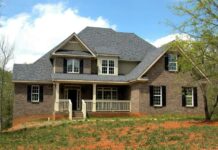
Dreaming of your log cabin getaway, where the tranquility of nature and the charm of rustic living come together? Embarking on this journey is exciting, but it comes with a set of challenges. While wanting to turn this dream into reality, you might wonder how to navigate the complexities of building a log home.
Your concerns are valid, and that’s why this article is here to guide you. Building a log home is a unique venture that requires careful planning and consideration of various factors.
Every decision matters, from selecting the right location that harmonizes with your vision to choosing the materials that suit your taste and climate.
Location
Consider the climate of the area you’re interested in. Log homes are known for their energy efficiency and warmth, but the climate can impact your choice of logs and insulation. Harsher winters may require thicker logs and better insulation to keep your retreat cozy.
Think about proximity to amenities. While the idea of seclusion is appealing, you’ll want to balance it with accessibility to essentials like groceries and medical facilities. Also, consider how far you will travel to reach your getaway. A remote location might offer solitude but pose maintenance and emergency services challenges.
Budgeting Wisely
According to the American Institute of Architects, log homes make up 9% of the custom-built homes being built in the US. As they become increasingly popular, it’s crucial to understand the cost of building these logs. Appraisal Buzz estimates that the building cost of a log home can be around $450,000 per unit. Thus, when it comes to building your log home getaway, budgeting wisely is essential.
Dreaming of a cozy cabin in the woods is one thing, but turning that dream into reality requires careful financial planning. Calculate how much you can comfortably afford, factoring in not only the construction costs but also ongoing expenses like property taxes, utilities, and maintenance. Remember that log homes often require more upkeep than traditional houses, so consider those long-term costs.
Next, get multiple quotes from builders and contractors. Don’t settle for the first offer; shop around to ensure you get the best value. Consider the cost of materials, as different types of wood and finishes can significantly affect your overall expenses.
Log Home Design and Style
Start by considering the layout. Consider your requirements for the number of bedrooms and bathrooms. Also, the size of the kitchen and living areas and whether you want an open floor plan or more defined spaces.
Your lifestyle and preferences should guide these decisions. Additionally, log home kit manufacturers can be a valuable resource when it comes to design. They offer pre-designed log home kits that can save time and simplify construction. These kits often come in various styles, from traditional rustic to modern, allowing you to choose the one that suits your vision.
However, don’t forget the exterior design. According to American Log Homes, the look of your log home from the outside is just as essential as the interior. You can consider choosing plans depending on the cabin size based on your preference.
For instance, large log cabin plans feature open floors, high ceilings, and many windows. Alternatively, you may select a medium log cabin with A-frame cabins and conventional two-story houses. Thus, factors like roof style, porches, and landscaping to complement the natural surroundings can also add value.
Choosing the Right Materials
Consider the type of logs you’ll use. Various wood species provide distinct aesthetics and levels of durability. Pine, cedar, and spruce are common choices, each with its characteristics. Your choice should align with your desired look and the local climate.
You might also consider log home kit manufacturers offering pre-cut logs and materials. These kits can simplify the construction process, but research carefully to ensure you get quality materials from a reputable manufacturer.
Furthermore, think about insulation. Proper insulation is vital for maintaining a comfortable indoor environment year-round. Many log homes incorporate insulation between the logs, while others opt for a double-wall construction with insulation in the middle.
Finding the Right Professionals
Finding the right professionals to help you build your log home getaway is paramount to a successful project. One of the first steps is seeking experienced architects or designers specializing in log home construction.
When selecting log home kit manufacturers, thorough research is essential. Look for reputable companies with a track record of delivering high-quality kits and excellent customer support. Reading reviews and seeking recommendations from other log homeowners can be valuable.
Hiring a skilled contractor with experience in log home construction is another crucial step. A competent contractor can ensure that your log home is built to the highest standards, minimizing potential issues down the road.
Navigating Permits and Regulations
Start by researching local zoning laws and building codes specific to your chosen area. These regulations can dictate everything from the size and design of your log home to its proximity to property lines and environmental considerations. It’s advisable to consult with local authorities or hire professionals well-versed in local regulations to ensure your project complies.
Additionally, construction standards must be followed, according to Log Home Living Magazine. All facets of the building codes industry are governed by ICC 400-2012, a publication of the International Codes Council (ICC).
It implies that all construction types whose main structural components are made up of an assembly of logs must comply with ICC 400-2012. The includes administrative requirements, general specifications, structural requirements, and five fundamental standards.
Sustainability and Energy Efficiency
Start by choosing sustainably sourced logs. Seek wood that has obtained certification from reputable organizations such as the Forest Stewardship Council (FSC) to guarantee sustainable and responsible forestry practices. Sustainable logging helps preserve forests and ensures a steady supply of quality wood for the future.
Include energy-saving lighting fixtures and appliances in your log home. LED lights, energy star-rated appliances, and programmable thermostats can significantly reduce energy consumption without sacrificing comfort.
Additionally, according to Realtor, keep a note of the efficiency and the utility costs, which may go hand in hand. The majority of new log cabins are constructed with insulation between the walls. The cabins become substantially more energy-efficient as a result. These cabins can save your energy costs by up to 30% since they preserve the heat within the cabin.
But given where you choose to construct, you might need to run power or establish a well or water on the site. Then, installing utilities might cost up to USD 10,000.
Clear Vision and Careful Planning Are Essential
Building a log home is about crafting a space that suits your needs, respects the environment, and fits within your budget. Finding the right professionals, navigating regulations, and prioritizing sustainability are all crucial steps in this adventure.
Remember, while challenges may arise, your log home can become a serene retreat with careful planning and a clear vision. Here, you can truly escape the hustle and bustle of everyday life.
Read More: Home improvement: Using a Chainsaw for Gardening





























































